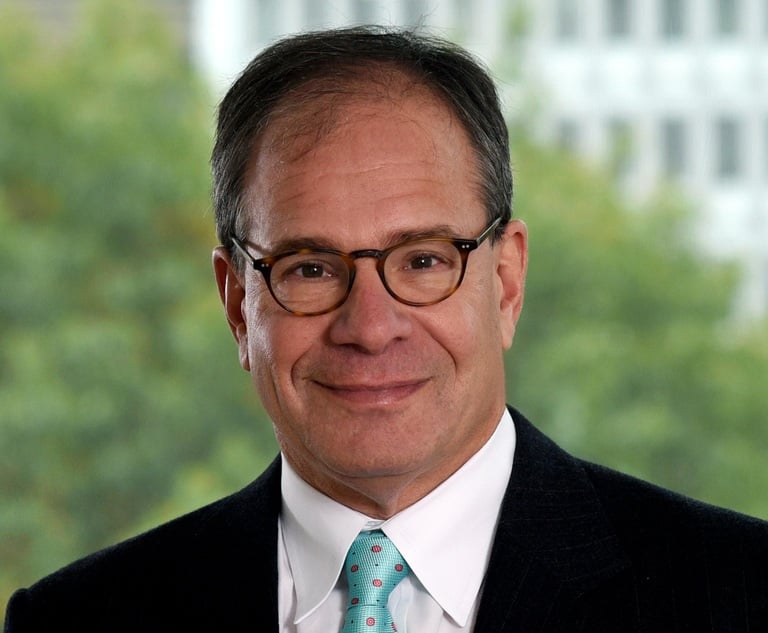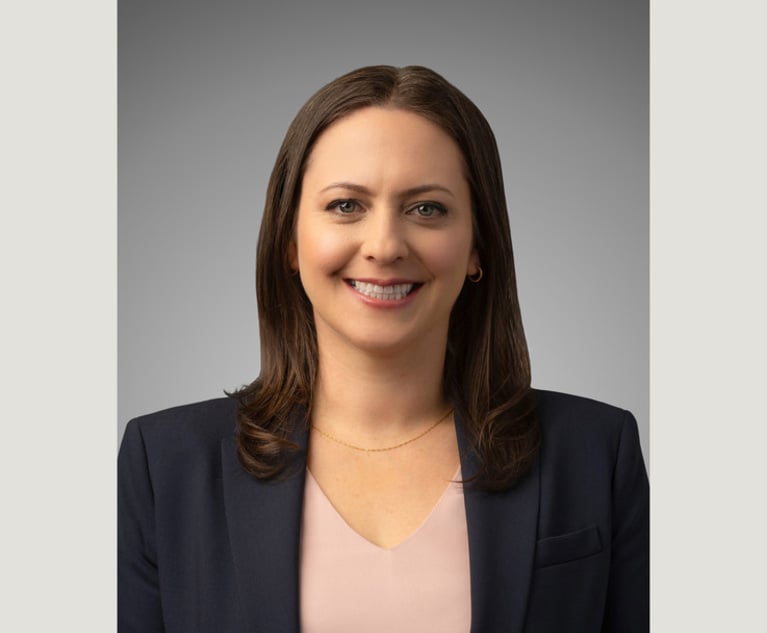New York Partner Promotions Up 27 Percent at Top Firms
In another sign of generally robust health among New York's biggest firms, the latest crop of new partners is the largest in years.
April 20, 2018 at 03:30 PM
6 minute read

The ranks of newly-minted, New York-based partners working at the state's largest law firms grew nearly 30 percent in the last year, continuing a trend of rising partner promotions in recent years.
The New York Law Journal surveys and tracks partner promotion classes, both firmwide and in New York, of the 25 firms employing the most lawyers in the state, as ranked by the NYLJ 100.
In the last year, the top 25 firms promoted 147 New York lawyers to partner, about a 27 percent increase from their previous round of promotions. Firmwide, this same group of firms promoted 411 lawyers to partner, up 22 percent from the previous year.
The increase in new partners in the last year may be a natural fluctuation after a drop in promotions last year. But other factors are at play this year, including some firms with possibly a record high number of promotions, and a healthier partner pipeline at New York firms in the post-recession period.
A look back from 2012 to 2018 shows a slow and steady rise in Manhattan promotions amid the 20 largest law firms in New York. (The group of five firms that make up the last fifth of the top 25 changes every year based on shifts in relative head count.)
The Law Journal in 2012 found the top 20 firms promoted about 70 New York lawyers to partner; in 2014, the same firms promoted about 83 to partner; and in 2016, they promoted about 102.
Two years later, these same firms promoted about 125 New York lawyers to partner—the largest recorded number in at least the last six years, if not longer.
Several firms had their largest promotion class in New York in recent years. They include Kirkland & Ellis, promoting 24 New York lawyers to partner in the last year; Milbank, Tweed, Hadley & McCloy, promoting six to partner in New York; and Shearman & Sterling, promoting seven to partner in New York.
Managed Growth
The steady rise in New York promotions coincides with a period of revenue and profit growth for many Wall Street firms in the last two years.
According to surveys by Citi Private Bank's Law Firm Group, equity partner head count for the legal industry was down 0.3 percent in 2017 from 2016. New York-headquartered firms, in contrast, saw a 0.5 percent increase.
Gretta Rusanow, head of advisory services at the bank's law firm group, points to “wide dispersion” behind Citi's figures, noting that some profitable New York-headquartered firms saw equity partner growth rates above 1 to 2 percent last year.
Still, Rusanow said she continues to see a “long-standing trend of careful management” of equity partner head count. The 2017 equity partner head count changes are consistent with the slight to moderate fluctuations she has seen in recent years, she said.
And while some firms may be promoting more lawyers to partners in recent years, if equity ranks are staying steady, firms must have a steady of flow of exits, including through retirements, lateral moves or counseling out unproductive partners.
“We know that firms have continued to promote from within, but we also see the equity partner head count number is essentially flat,” Rusanow said. “It does beg the question, have those firms seen an increase in their departures or retirement from equity partnership?”
Of course, some firms' new partners are in the non-equity ranks. Among the 25 law firms surveyed here, about half have non-equity and equity tiers, according to National Law Journal data.
At White & Case, each of the firm's last two rounds of partner promotions in New York—nine in 2017 and 10 in 2016—have been more than double the number in the previous four years, when the firm was promoting three or four lawyers to partner in Manhattan.
David Koschik, member of White & Case's executive committee, said the large promotions classes don't indicate a corresponding number of exits. “There's always a certain number of departures and retirements, of course, but we have grown and continue to grow the overall partner head count not just in New York, but across the U.S. and globe,” he said.
“As part of our 2020 strategy, we targeted growth in the U.S., specifically in New York, as a key goal. We're doing that two ways, both by lateral partner additions as well as through organic growth, promoting from within,” Koschik said. “We've had a very strong pipeline of candidates for partnership over the past few years and think that will continue.”
While most of the top 25 firms saw an increase in New York partner promotions, nine saw declines. Mainly those declines were slight, but some saw steeper drops in New York: Sidley Austin and Cleary Gottlieb Steen & Hamilton each promoted only two New York lawyers to partner—one of the lowest number of New York promotions in the last six years for both firms.
Meanwhile, firms continue to make little if any progress on promoting more women to partner. Among all firmwide promotions at the top 25 law firms, about 32 percent of all new partners of the 25 largest firms were women. That's higher than last year's proportion, but about the same as two years ago.
Two of the 25 surveyed firms promoted no women to partner in their most recent round of promotions: Weil Gotshal & Manges, which promoted 10 men, and Schulte Roth & Zabel, which promoted two men. Meanwhile, in the last year, Paul, Weiss, Rifkind, Wharton & Garrison; Skadden, Arps, Slate, Meagher & Flom; Sullivan & Cromwell; Fried, Frank, Harris, Shriver & Jacobson; and Cahill Gordon & Reindel promoted only one woman to partner.
This content has been archived. It is available through our partners, LexisNexis® and Bloomberg Law.
To view this content, please continue to their sites.
Not a Lexis Subscriber?
Subscribe Now
Not a Bloomberg Law Subscriber?
Subscribe Now
NOT FOR REPRINT
© 2025 ALM Global, LLC, All Rights Reserved. Request academic re-use from www.copyright.com. All other uses, submit a request to [email protected]. For more information visit Asset & Logo Licensing.
You Might Like
View All

Alston & Bird Adds M&A, Private Equity Team From McDermott in New York
4 minute read
Reflections on the Changing Legal Profession Upon 40 Years in Practice

Weil Lures DOJ Antitrust Lawyer, As Government Lateral Moves Pick Up Before Inauguration Day
5 minute readTrending Stories
- 1Avantia Publicly Announces Agentic AI Platform Ava
- 2Shifting Sands: May a Court Properly Order the Sale of the Marital Residence During a Divorce’s Pendency?
- 3Joint Custody Awards in New York – The Current Rule
- 4Paul Hastings, Recruiting From Davis Polk, Adds Capital Markets Attorney
- 5Chancery: Common Stock Worthless in 'Jacobson v. Akademos' and Transaction Was Entirely Fair
Who Got The Work
J. Brugh Lower of Gibbons has entered an appearance for industrial equipment supplier Devco Corporation in a pending trademark infringement lawsuit. The suit, accusing the defendant of selling knock-off Graco products, was filed Dec. 18 in New Jersey District Court by Rivkin Radler on behalf of Graco Inc. and Graco Minnesota. The case, assigned to U.S. District Judge Zahid N. Quraishi, is 3:24-cv-11294, Graco Inc. et al v. Devco Corporation.
Who Got The Work
Rebecca Maller-Stein and Kent A. Yalowitz of Arnold & Porter Kaye Scholer have entered their appearances for Hanaco Venture Capital and its executives, Lior Prosor and David Frankel, in a pending securities lawsuit. The action, filed on Dec. 24 in New York Southern District Court by Zell, Aron & Co. on behalf of Goldeneye Advisors, accuses the defendants of negligently and fraudulently managing the plaintiff's $1 million investment. The case, assigned to U.S. District Judge Vernon S. Broderick, is 1:24-cv-09918, Goldeneye Advisors, LLC v. Hanaco Venture Capital, Ltd. et al.
Who Got The Work
Attorneys from A&O Shearman has stepped in as defense counsel for Toronto-Dominion Bank and other defendants in a pending securities class action. The suit, filed Dec. 11 in New York Southern District Court by Bleichmar Fonti & Auld, accuses the defendants of concealing the bank's 'pervasive' deficiencies in regards to its compliance with the Bank Secrecy Act and the quality of its anti-money laundering controls. The case, assigned to U.S. District Judge Arun Subramanian, is 1:24-cv-09445, Gonzalez v. The Toronto-Dominion Bank et al.
Who Got The Work
Crown Castle International, a Pennsylvania company providing shared communications infrastructure, has turned to Luke D. Wolf of Gordon Rees Scully Mansukhani to fend off a pending breach-of-contract lawsuit. The court action, filed Nov. 25 in Michigan Eastern District Court by Hooper Hathaway PC on behalf of The Town Residences LLC, accuses Crown Castle of failing to transfer approximately $30,000 in utility payments from T-Mobile in breach of a roof-top lease and assignment agreement. The case, assigned to U.S. District Judge Susan K. Declercq, is 2:24-cv-13131, The Town Residences LLC v. T-Mobile US, Inc. et al.
Who Got The Work
Wilfred P. Coronato and Daniel M. Schwartz of McCarter & English have stepped in as defense counsel to Electrolux Home Products Inc. in a pending product liability lawsuit. The court action, filed Nov. 26 in New York Eastern District Court by Poulos Lopiccolo PC and Nagel Rice LLP on behalf of David Stern, alleges that the defendant's refrigerators’ drawers and shelving repeatedly break and fall apart within months after purchase. The case, assigned to U.S. District Judge Joan M. Azrack, is 2:24-cv-08204, Stern v. Electrolux Home Products, Inc.
Featured Firms
Law Offices of Gary Martin Hays & Associates, P.C.
(470) 294-1674
Law Offices of Mark E. Salomone
(857) 444-6468
Smith & Hassler
(713) 739-1250






